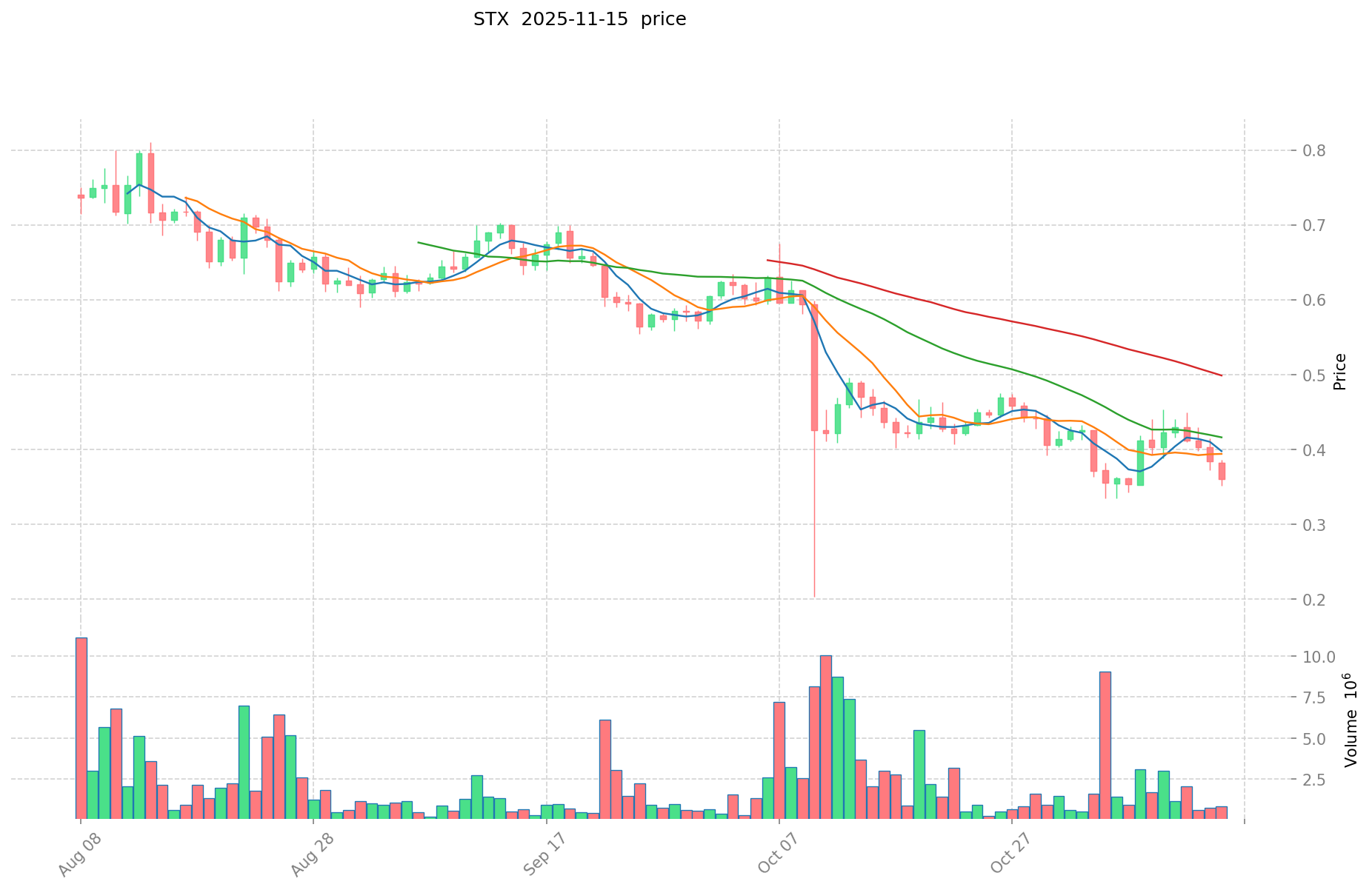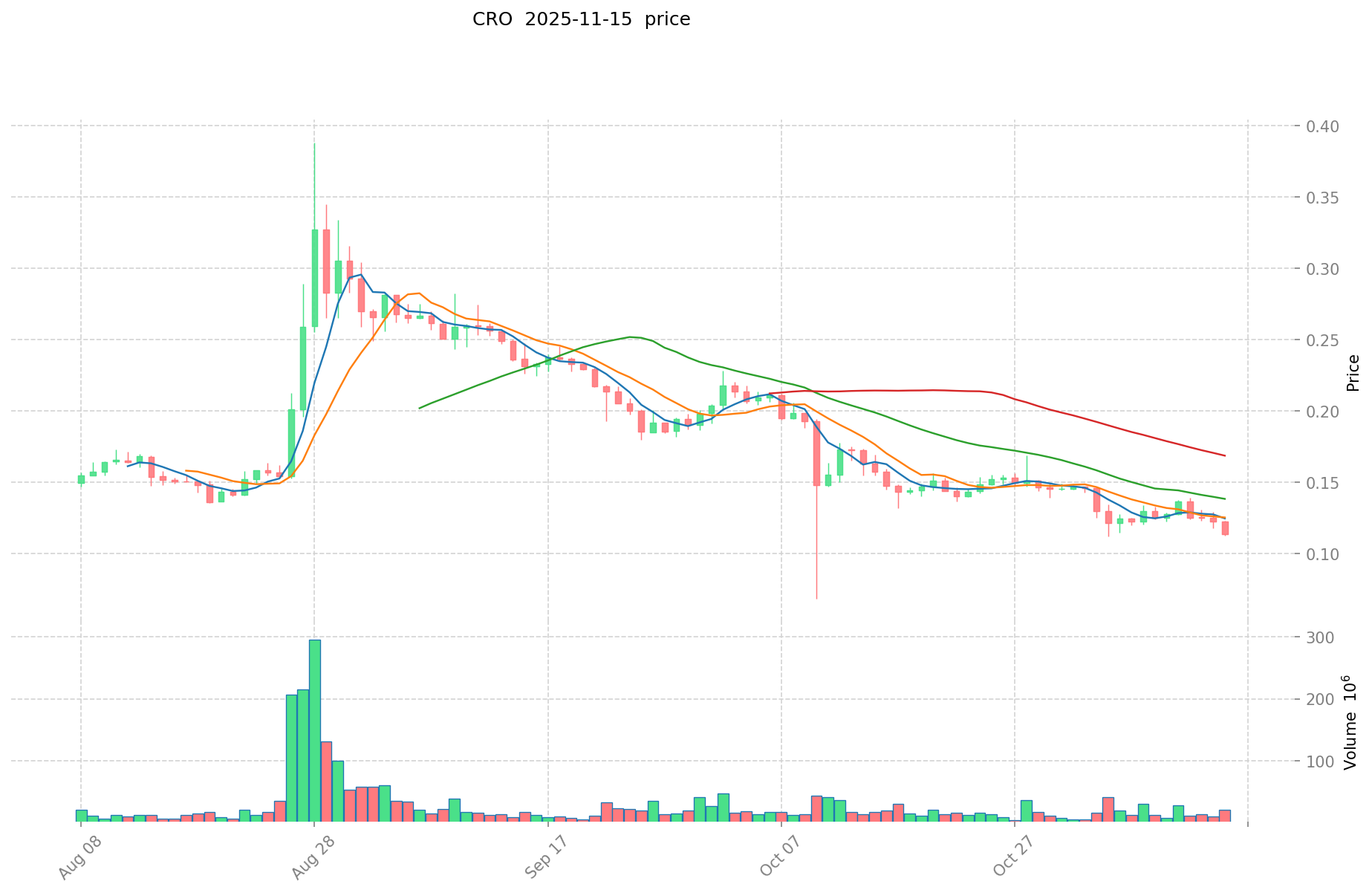STX vs CRO: Comparing Two Rising Stars in the Crypto Market
Introduction: STX vs CRO Investment Comparison
In the cryptocurrency market, the comparison between Stacks (STX) and Cronos (CRO) has been an unavoidable topic for investors. The two not only show significant differences in market cap ranking, application scenarios, and price performance, but also represent different positions in the crypto asset landscape.
Stacks (STX): Since its launch in 2019, it has gained market recognition for its vision of a new decentralized internet with built-in privacy and user data control.
Cronos (CRO): Introduced in 2018, it has been hailed as a leading blockchain ecosystem, partnering with Crypto.com and numerous developers to serve a global user base.
This article will provide a comprehensive analysis of the investment value comparison between STX and CRO, focusing on historical price trends, supply mechanisms, institutional adoption, technological ecosystems, and future predictions, aiming to answer the question most concerning to investors:
"Which is the better buy right now?"
I. Price History Comparison and Current Market Status
STX and CRO Historical Price Trends
- 2024: STX reached its all-time high of $3.86 on April 1, 2024, likely due to significant network upgrades or partnerships.
- 2021: CRO hit its all-time high of $0.965407 on November 24, 2021, possibly influenced by Crypto.com's aggressive marketing campaigns and partnerships.
- Comparative analysis: During the recent market cycle, STX dropped from its high of $3.86 to a current price of $0.3598, while CRO declined from $0.965407 to $0.11375.
Current Market Situation (2025-11-15)
- STX current price: $0.3598
- CRO current price: $0.11375
- 24-hour trading volume: STX $308,809.92 vs CRO $2,475,691.43
- Market Sentiment Index (Fear & Greed Index): 16 (Extreme Fear)
Click to view real-time prices:
- Check STX current price Market Price
- Check CRO current price Market Price


II. Core Factors Affecting the Investment Value of STX vs CRO
Supply Mechanisms Comparison (Tokenomics)
- STX: Fixed supply cap of 1.818 billion tokens, with decreasing block rewards over time
- CRO: Fixed maximum supply of 30 billion tokens, with regular token burns to reduce supply
- 📌 Historical pattern: Fixed supply models typically create scarcity that can drive price appreciation during bull markets, while token burns (like those implemented by CRO) can create deflationary pressure over time.
Institutional Adoption and Market Applications
- Institutional holdings: STX has gained attention from institutional investors interested in Bitcoin layer-2 solutions, while CRO has institutional support through Crypto.com's exchange partnerships
- Enterprise adoption: STX offers Bitcoin-based smart contracts for financial applications, while CRO powers Crypto.com's payment ecosystem with broader merchant adoption
- Regulatory attitudes: Both tokens face varying regulatory scrutiny across jurisdictions, with CRO benefiting from Crypto.com's compliance-focused approach in multiple markets
Technical Development and Ecosystem Building
- STX technical upgrades: Implementation of the Nakamoto release to improve scalability and Bitcoin integration through sBTC
- CRO technical development: Evolution from Crypto.com Chain to Cronos, supporting EVM compatibility and cross-chain functionality
- Ecosystem comparison: STX focuses on Bitcoin-centric DeFi applications and ordinals, while CRO has a broader ecosystem spanning payments, NFTs, and DeFi applications on Cronos
Macroeconomic Factors and Market Cycles
- Performance in inflationary environments: STX benefits from its connection to Bitcoin's inflation-resistant properties, while CRO's value is more tied to exchange activity and utility
- Macroeconomic monetary policy: Interest rate changes affect trading volumes on Crypto.com, impacting CRO demand, while STX may benefit from Bitcoin's potential role as a digital store of value
- Geopolitical factors: Cross-border payment needs and international restrictions on crypto exchanges can affect adoption rates for both tokens differently
III. 2025-2030 Price Prediction: STX vs CRO
Short-term Prediction (2025)
- STX: Conservative $0.22 - $0.36 | Optimistic $0.36 - $0.39
- CRO: Conservative $0.08 - $0.11 | Optimistic $0.11 - $0.13
Mid-term Prediction (2027)
- STX may enter a growth phase, with estimated prices $0.38 - $0.56
- CRO may enter a steady growth phase, with estimated prices $0.11 - $0.16
- Key drivers: Institutional fund inflows, ETFs, ecosystem development
Long-term Prediction (2030)
- STX: Base scenario $0.62 - $0.76 | Optimistic scenario $0.76 - $0.85
- CRO: Base scenario $0.17 - $0.25 | Optimistic scenario $0.25 - $0.30
Disclaimer: This analysis is based on historical data and current market trends. Cryptocurrency markets are highly volatile and unpredictable. This information should not be considered as financial advice. Always conduct your own research before making investment decisions.
STX:
| 年份 | 预测最高价 | 预测平均价格 | 预测最低价 | 涨跌幅 |
|---|---|---|---|---|
| 2025 | 0.386052 | 0.3642 | 0.222162 | 1 |
| 2026 | 0.49141506 | 0.375126 | 0.32635962 | 4 |
| 2027 | 0.563251689 | 0.43327053 | 0.3769453611 | 20 |
| 2028 | 0.622826386875 | 0.4982611095 | 0.284008832415 | 38 |
| 2029 | 0.672652497825 | 0.5605437481875 | 0.3363262489125 | 55 |
| 2030 | 0.76458167252775 | 0.61659812300625 | 0.388456817493937 | 71 |
CRO:
| 年份 | 预测最高价 | 预测平均价格 | 预测最低价 | 涨跌幅 |
|---|---|---|---|---|
| 2025 | 0.1280048 | 0.11429 | 0.0788601 | 0 |
| 2026 | 0.135685088 | 0.1211474 | 0.07268844 | 6 |
| 2027 | 0.15795198012 | 0.128416244 | 0.11300629472 | 12 |
| 2028 | 0.1732527755926 | 0.14318411206 | 0.1030925606832 | 25 |
| 2029 | 0.18986213259156 | 0.1582184438263 | 0.118663832869725 | 39 |
| 2030 | 0.248877612138769 | 0.17404028820893 | 0.149674647859679 | 53 |
IV. Investment Strategy Comparison: STX vs CRO
Long-term vs Short-term Investment Strategies
- STX: Suitable for investors focused on Bitcoin integration and DeFi potential
- CRO: Suitable for investors interested in exchange ecosystems and payment solutions
Risk Management and Asset Allocation
- Conservative investors: STX: 30% vs CRO: 70%
- Aggressive investors: STX: 60% vs CRO: 40%
- Hedging tools: Stablecoin allocation, options, cross-token portfolio
V. Potential Risks Comparison
Market Risks
- STX: Highly dependent on Bitcoin's performance and adoption of layer-2 solutions
- CRO: Closely tied to Crypto.com's success and overall exchange market conditions
Technical Risks
- STX: Scalability challenges, network stability during high-demand periods
- CRO: Centralization concerns, potential security vulnerabilities in the ecosystem
Regulatory Risks
- Global regulatory policies may impact both tokens differently, with CRO potentially facing more scrutiny due to its association with a centralized exchange
VI. Conclusion: Which Is the Better Buy?
📌 Investment Value Summary:
- STX advantages: Bitcoin integration, smart contract functionality, fixed supply cap
- CRO advantages: Established ecosystem, regular token burns, wide merchant adoption
✅ Investment Advice:
- New investors: Consider a balanced approach, leaning towards CRO for its established ecosystem
- Experienced investors: Explore STX for its Bitcoin integration potential and growth prospects
- Institutional investors: Evaluate both tokens based on specific portfolio needs and risk tolerance
⚠️ Risk Warning: Cryptocurrency markets are highly volatile. This article does not constitute investment advice. None
VII. FAQ
Q1: What are the key differences between STX and CRO in terms of investment potential? A: STX is focused on Bitcoin integration and DeFi potential, making it suitable for investors interested in Bitcoin layer-2 solutions. CRO, on the other hand, is part of a broader exchange ecosystem and payment solutions, appealing to those interested in centralized exchange tokens and wider merchant adoption.
Q2: How do the supply mechanisms of STX and CRO compare? A: STX has a fixed supply cap of 1.818 billion tokens with decreasing block rewards over time. CRO has a fixed maximum supply of 30 billion tokens but implements regular token burns to reduce supply, creating potential deflationary pressure.
Q3: Which token has shown better price performance in recent years? A: STX reached its all-time high of $3.86 in April 2024, while CRO hit its all-time high of $0.965407 in November 2021. However, both have seen significant declines since their peaks, with STX currently at $0.3598 and CRO at $0.11375 as of November 15, 2025.
Q4: What are the main risks associated with investing in STX and CRO? A: For STX, risks include high dependence on Bitcoin's performance and potential scalability challenges. CRO faces risks tied to Crypto.com's success, centralization concerns, and potential regulatory scrutiny due to its association with a centralized exchange.
Q5: How do analysts predict the future prices of STX and CRO? A: By 2030, analysts predict STX could reach between $0.62 - $0.85 in optimistic scenarios, while CRO is expected to be in the range of $0.17 - $0.30. These predictions are based on various factors including ecosystem development, institutional adoption, and market trends.
Q6: Which token might be more suitable for conservative investors? A: Conservative investors might consider allocating more to CRO (70%) compared to STX (30%) due to CRO's established ecosystem and wider merchant adoption. However, individual risk tolerance and investment goals should always be considered.
Q7: How do institutional adoptions differ between STX and CRO? A: STX has gained attention from institutional investors interested in Bitcoin layer-2 solutions, while CRO benefits from institutional support through Crypto.com's exchange partnerships and compliance-focused approach in multiple markets.
Share
Content